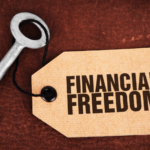
Embarking on the journey to financial freedom is a pursuit of living life on your terms, liberated from the constraints of paycheck dependency and financial worries. This article simplifies the path to financial freedom, breaking it down into achievable steps and essential strategies. Whether you’re laying the first stone or building upon a foundation of financial security, we provide insights and guidance to navigate your way to economic independence. Discover the true essence of financial freedom and learn how to achieve it with practical, actionable advice.
Financial Freedom: Defining Your Dreams
Embarking on the path to financial freedom isn’t just about following financial advice; it’s about defining what a financially free life looks like for you. Before diving into the strategies and tips this guide offers, take a moment to reflect on your vision of financial freedom. Is it the ability to work on your terms, the security of a robust savings account, or perhaps the joy of living debt-free?
This exploration encourages you to pause and consider your unique goals and aspirations. With a clear vision of what financial freedom means to you, the steps outlined here will not only be more meaningful but also more impactful, guiding you toward a future where your financial decisions align perfectly with your dreams and lifestyle.
1. Embrace a Budgeting Mindset
Budgeting is your roadmap to financial success. It’s about understanding where your money goes and reallocating resources to prioritize savings and investments.
- Tips for Effective Budgeting:
- Track your spending for at least a month to identify where you can cut back.
- Use budgeting apps to simplify the tracking and planning process.
- Allocate funds for entertainment and personal treats to avoid budget burnout.
2. Build a Solid Emergency Fund
An emergency fund is crucial for weathering life’s unexpected financial storms without derailing your financial plans.
- Tips for Building Your Emergency Fund:
- Start small, even if it’s just a few dollars each payday, and gradually increase.
- Keep your emergency fund in a high-yield savings account for easy access.
- Automate your savings to ensure consistent contributions without having to think about it.
3. Strategically Eliminate Debt
High-interest debt can consume your finances. Prioritize paying off these debts to free up more money for savings and investments.
- Debt Reduction Tips:
- Focus on paying off high-interest debts first while making minimum payments on others.
- Consider debt consolidation or refinancing for lower interest rates.
- Celebrate small victories along the way to keep motivated.
4. Maximize Your Income
Increasing your income provides more leverage for savings and investments, accelerating your path to financial freedom.
- Tips for Increasing Income:
- Negotiate your salary or seek higher-paying job opportunities.
- Explore side hustles that align with your skills and interests.
- Consider passive income streams, such as rental income or dividend-paying stocks.
5. Wise Investing Is Key
Investing is how you grow your wealth over time. Start with low-risk options and gradually diversify your portfolio.
- Investing Tips:
- Educate yourself on basic investment principles and strategies.
- Start with index funds or mutual funds for diversification.
- Don’t let market fluctuations lead to panic selling; investing is a long-term strategy.
6. Protect Your Wealth with Insurance
Insurance prevents catastrophic events from wiping out your financial progress. Adequate coverage is non-negotiable.
- Insurance Best Practices:
- Regularly review your insurance coverage to ensure it meets your current needs.
- Shop around for the best rates and coverage options.
- Consider life, health, and disability insurance as foundational elements of your financial plan.
7. Plan for Retirement Early
The sooner you start saving for retirement, the more you’ll benefit from the power of compound interest.
- Retirement Planning Tips:
- Take full advantage of employer-matched retirement plans.
- Increase your contribution percentage annually or with every salary increase.
- Consider talking to a financial advisor to tailor your retirement plan to your specific needs.
8. Live Below Your Means
Living below your means allows you to save more and invest in your future without sacrificing your quality of life.
- Tips for Sustainable Living:
- Differentiate between wants and needs to make smarter spending decisions.
- Practice mindful spending by waiting 24-48 hours before making significant purchases.
- Find affordable ways to enjoy life, like free community events or at-home entertainment.
9. Educate Yourself Financially
Continuous learning is key to making informed financial decisions. Stay updated on financial news, trends, and strategies.
- Financial Education Tips:
- Read one financial book or article daily.
- Follow reputable financial news sources and influencers.
- Join financial forums or online communities to learn from others’ experiences.
10. Set Financial Goals and Review Them Regularly
Clear, achievable financial goals guide your financial decisions and help you stay focused on your long-term vision.
- Goal-Setting Best Practices:
- Write down your goals and the steps needed to achieve them.
- Review and adjust your goals regularly to reflect your financial situation and priorities.
- Use financial milestones to celebrate progress and stay motivated.
Conclusion
Financial freedom isn’t about how much money you make but how you manage and grow it. By following these steps and incorporating the tips into your financial strategy, you’ll be on your way to a secure and independent financial future. Remember, the journey to financial freedom is a marathon, not a sprint. Stay disciplined, stay informed, and most importantly, stay committed to your financial well-being.

FAQs
1. What is financial freedom?
Financial freedom is achieved when you have accumulated enough wealth, including savings and investments, to support your desired lifestyle indefinitely without relying on regular employment for income. It signifies the ability to make life choices without financial constraints.
2. Can you explain the seven levels of financial freedom?
- Level 1: Clarity – Understanding your financial status and goals.
- Level 2: Self-Sufficiency – Managing to live within your means.
- Level 3: Protection – Having insurance and emergency funds to safeguard against unforeseen events.
- Level 4: Debt Freedom – Eliminating consumer debt and loans with high interest.
- Level 5: Security – Possessing enough investments to cover the essentials of living.
- Level 6: Independence – Achieving the capability to sustain your lifestyle solely through savings and investments.
- Level 7: Abundance – Accumulating wealth that far exceeds your needs, allowing for generosity and the pursuit of passions.
3. What are the five pillars of financial freedom?
- Pillar 1: Income – Generating multiple income streams, both active and passive.
- Pillar 2: Savings – Regularly setting aside a portion of your income for future use.
- Pillar 3: Investment – Utilizing investments to grow your wealth over time.
- Pillar 4: Expense Management – Controlling spending to ensure it remains below your means.
- Pillar 5: Financial Education – Continually enhancing your knowledge and skills in financial management.
4. What does the 4% rule entail for achieving financial freedom?
The 4% rule is a guideline for retirement spending, suggesting you can safely withdraw 4% of your retirement savings annually, adjusted for inflation, without depleting your funds over a 30-year period. This rule helps determine the total savings needed for retirement based on your annual expenses.
5. How much money is needed to retire comfortably?
The exact amount needed for retirement varies based on individual lifestyle choices, expenses, and other factors. A general guideline is to accumulate a retirement fund that is 25 times your expected annual expenses, as per the 4% withdrawal rule. For example, if you anticipate annual retirement expenses of $40,000, you should aim for a savings goal of $1 million.
6. Could you provide examples of achieving financial freedom?
Examples of financial freedom include:
- Choosing a career based on passion rather than salary.
- Retiring early to explore new hobbies or travel.
- Generating sufficient passive income, such as dividends, to support your lifestyle.
- Being mortgage-free and living without personal debt.
- Financially assisting loved ones or contributing to charitable causes.
- Investing in projects driven by interest and passion, rather than financial gain alone.
Additional Resources
- For Budgeting and Expense Tracking:
- Mint: A leading budgeting tool that helps users effortlessly track their spending and manage finances.
- For Emergency Funds and High-Yield Savings Accounts:
- EQ Bank: Known for their high-interest savings accounts, perfect for building an emergency fund without traditional banking services.
- For Debt Management Solutions:
- Credit Karma: Offers free credit scores, reports, and insights, plus recommendations for managing and consolidating debt.
- For Increasing Income through Investments:
- Wealthsimple: Provides an easy, automated way for Canadians to invest in diversified portfolios online.
- For Investment Platforms for Diversification:
- Questrade: Enables Canadians to invest in stocks, bonds, mutual funds, and ETFs at lower costs, fostering portfolio diversification.
- For Insurance Solutions:
- PolicyAdvisor: An innovative online platform for comparing and purchasing life, health, and disability insurance.






This site is fabulous. The radiant material shows the publisher’s enthusiasm. I’m dumbfounded and envision more such astonishing material.